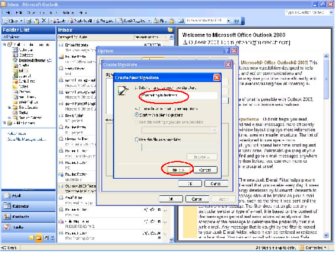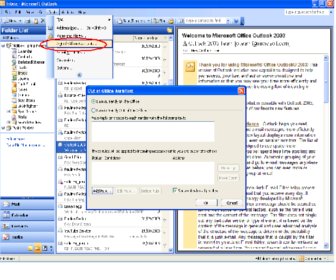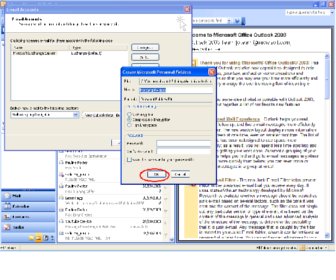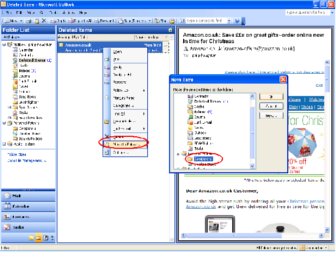Working With Outlook
Before you start sending emails with Outlook you need to create a email signature.
A signature on all business emails is required by law and must include your name, company name, company address, registration no. etc.
Use the buttons below to navigate through the lesson
- With your Inbox displayed select “Tools”.
- Then “Options”
- Click the “Mail Format” tab.
- Click “Signatures”
- Click “New”
- In the “Create New Signature” box, type a name for your signature file, then click “Next”.

- In the Edit Signature box, type your name and any additional text as you would like it to display in outgoing email messages.
- When you are done, click “Finish” then click “OK”.
- Make sure that the name of your newly created signature file is displayed in the “Signature for New Messages” portion of the Options screen. Then click Apply, then click OK.
- Your signature will now appear on all your new emails.
- Sending a email is very easy. Click “New”
- From here add the email address you wish to send to and any additional addresses in Carbon Copy “Cc”.
- Enter your email title in “Subject”. Write your email in the text box and click “Send” when done.
- There are additional options which you may wish to select prior to sending your email. Click “Options”.
- The “Importance” and “Sensitivity” boxes alert the recipient to the nature of your email.
- The “Request” check boxes if checked will notify you when your email has been delivered and read by the recipient.
- To add a attachment to your email click “Insert File”.
- Then Browse for the file you wish to add and click “Insert”.
- The file has now been attached to your email.
- Once you have received a email you have various options that can be applied. They are “Reply” and “Reply to All”, “Forward” and “Follow up”.
- Replying to Email: To reply to an open email message, click the “Reply” button on the toolbar. Type your reply then click “Send”. There is also a “Reply To All” button that allows you to reply to all recipients of the original mail, including those that were carbon copied and blind carbon copied.
- Forwarding Email: Clicking on the “Forward” button allows you to forward the email to another individual. The email displays in a new window and you must type or select the email address of the desired recipient, type a message of your own if appropriate, and then click the “Send” button.
- Flagging Email For Follow Up: You can place a flag on email as a way to remind yourself that additional action needs to be taken. To flag an email for follow up, click the “Follow Up” button. Then select the color flag you would like to use and a date and time to Follow Up.
- You can add frequently used email addresses to a Personal Address book.
From the menu, select File, New, Contact. - Type the name of the contact, and the email address
- When you are done, click “Save and Close”
- Distribution lists simplify the process of sending mail to groups of individuals.
- For example, if you frequently email everyone in your department, you might wish to create a distribution list for your department.
- To create a distribution list, select “File”, “New”, “Distribution List” from the Inbox menu
- The Distribution List dialog box displays. Type a name for the Distribution list in the Name field
- Click “Select Members” to select members from the global address list or your personal address book
- If the individual is not on the global address list, you can click “Add New” in the Distribution List dialog box
- Clicking “Add New” displays a dialog box in which you type the display name and email address of the individual you are adding to the distribution list
- Click “Ok” then “Save and Close” when you are done. Distribution lists are stored in the Contacts folder
- If you plan to be out of the office for a day or longer, you can use the Out of Office Assistant to automatically generate replies to any email you receive while you are gone.
- From the Inbox menu, select “Tools”, “Out of Office Assistant”. Complete the dialog box and click “OK” when you are done. This is shown on the next screen.
- MS Outlook will automatically send the response you indicate for as long as “I am currently out of the office” is selected.
- When you return to the office, follow the above steps and click “I am currently in the Office” to deactivate the Out Of Office Assistant.

- Saving and Storing Email (Personal Folders)
- Personal folders allow you to move mail from the email server to your computer, thereby reducing the chances of exceeding your mailbox’s storage capacity. Some additional notes:
- You cannot access your personal folders when you use the web to access Outlook.
- Messages can be dragged from your Inbox to your personal folders.
- Personal Folders should not be located under your mailbox’s Inbox.
- From the Inbox menu, select “Tools”, “E-Mail Accounts”, “View or change existing e-mail accounts”. Click “Next”
- Click New Outlook Data File
- Select either “Office Outlook Personal Folders File (pst) OR “Outlook 97-2002 Personal Folders File (pst) then click “OK”
- In this next dialog box, you will select the location for your personal folders. Personal folders should be stored C:\Outlook so that you can access them from any computer that you logon to.
- Once you have selected the Outlook folder click “OK”
- The following display box will appear, click “OK” to continue

- You are sent back to the Email Accounts screen. Click the “Finish” button. Your Personal Folders will now display in your Folder List.
- Once you have created Personal Folders, you may create subfolders to categorize your mail.
- To create a subfolder, right click on “Personal Folders” and from the shortcut menu, select “New Folder”.
- In the Create New Folder dialog box, name the folder. Make sure the “Folder contains” box indicates Mail and Post Items, and that Personal Folders is selected in the “Select Where to Place the Folder” box. Click “OK”.
- Moving Mail to A Personal Folder
- To move mail to a personal folder, select the message(s) you wish to move. You may Shift+Click to select a group of consecutive messages, or Control+Click to select multiple messages that are not consecutive.
- With the message(s) selected, right click and select Move to Folder from the shortcut menu.
- Select the appropriate personal folder from the list of folders that displays in the Move Items dialog box. Click “OK”.
- NOTE: You can also select the messages and drag them to the appropriate personal folder.

- The email has now been moved to the created Personal Folder